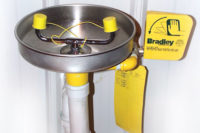
Do you acknowledge employees for doing the right things?
Typically, safety professionals are divided on using incentives to promote safety. Half think incentives are an effective way to promote safe behavior; the other half think they do nothing except encourage the underreporting or hiding of injuries. The debate is likely to continue.
OSHA and incentives
What is not debatable, however, is OSHA’s view of safety incentive programs. While there is no standard regarding incentive programs, the agency has addressed the topic. In an April 1996 Letter of Interpretation, OSHA says: “Some safety incentive programs actually present concerns to OSHA. Many employers have excellent safety incentive programs, but there are also some negative or dubious incentive programs that actually encourage employees to not report workplace injuries and illnesses.”
OSHA’s concern over the effectiveness of incentive programs continues. In July 2009, Jordan Barab, the Acting Assistant Secretary of Labor, said, “[OSHA] will also be taking a close look at programs that have the effect of discouraging workers from reporting injuries and illnesses. These include programs that discipline workers who are injured or safety competitions that penalize individual workers or groups of workers when someone reports an injury or illness.” During inspections, OSHA anticipates asking employees about incentive programs to determine the impact on reporting injuries.
To ensure compliance, all employers should evaluate their current safety incentive programs. The focus should be on determining whether your program acknowledges employees for doing the right things. In other words, do you reward proactive, not reactive, behavior?
Proactive behavior
Most safety incentive programs reward workers for “working safely” over a given period of time. In reactive safety incentive programs, this is commonly associated with a particular outcome such as, “working a year without getting hurt” or similar goal. Consequently, employees work toward that result.
If motivated by cash incentives or peer pressure not to “ruin” the company’s safety record, employees may use any strategy to achieve the desired result, including withholding injury reports. This can lead to more severe injuries in the future. An employee may choose to ignore a minor injury until it becomes so severe that he has no choice but to report it.
On the other hand, if an incentive program rewards workers for using safe work procedures and practices or participating in safety activities, the behavior is recognized before an accident occurs. This helps prevent accidents.
Rewards that work
The nature of the reward is not important. What is most important is that you recognize appropriate behavior in a meaningful way. In fact, under OSHA’s Voluntary Protection Programs guidelines, the agency says that incentive programs should be “…innovative, positive, and promote safety awareness and worker participation in safety-related activities…” This can be accomplished in a variety of ways.
RECOGNITION. You don’t necessarily have to spend money to reward employees. We like to be appreciated for what we do. Recognition for a job well done makes us feel valued, important and part of a team. Managers and supervisors should make a conscious effort to personally acknowledge and praise employees for their safety efforts.
CONTESTS. Reinforcing the same topics in the same way can make safety boring. This can easily cause employees to stop paying attention to your message and become complacent. To make safety “new” again, hold contests.
For example, ask employees to submit slogans for a safety poster. Have everyone vote on which one they like best. Give the person with the winning slogan an award (gift card or plaque), but consider awarding all employees who submitted a slogan with a smaller award (cap, cup, pin, etc.).
You could also hold an essay contest for employees’ children on “Why I want my mom/dad to work safely.” This approach will make employees think about safety through the importance of being with family. The incentive here is obvious.
Even if they don’t enter, your employees might spend a little extra time contemplating the importance of safety.
Suggestion program
Employees deal with safety problems you may never know about until an accident occurs. For many reasons, employees may be reluctant to discuss these issues with management. Encourage employees to do so by developing a suggestion program that is simple and easy to use.
All suggestions should be taken seriously and reviewed by the appropriate parties on a timely basis. Consider offering some type of reward for good suggestions that improve a safety process or procedure.
Point system
In a point-based incentive system, the emphasis is not placed on the occurrence of an injury. While this may still be a factor, the primary criteria for awarding points should be based on proactive safety behavior. For example, an employee might get one point for being injury-free, three points for making a safety suggestion, five points for conducting a safety inspection, etc.
Rewarding employees for these types of safety activities will force you to spread the points around. This ensures that as many employees as possible are actively engaged in your safety and health management program. A company cannot be successful in its safety and health efforts without employee involvement.
Safety bucks
Issuing safety bucks is a common way to reward safety efforts and a popular approach with employees. Make sure, however, that they are awarded to employees for proactive, not reactive, safety behavior. Have supervisors carry safety bucks and give them to employees when they do something impressive such as:
- Warning a coworker
- Identifying a hazard
- Reporting an injury immediately
- Making a suggestion that prevents injury
Reevaluate your safety incentives to ensure their effectiveness and that they do not become entitlements. No matter your approach, incentives always motivate some kind of behavior. The trick is to motivate proactive safety behavior.





